Art
Banana Ganesh
Read all about it here.
Posted By: Paul - Mon May 24, 2021 -
Comments (3)
Category: Animals, Art, Statues and Monuments, Food, Religion, Bananas
Art-Necko Ties
Minnesota artist Mark Larson debuted his line of Art-Necko ties in 1978. These were plastic, see-through ties, and the gimmick was that he filled them with various stuff.
source: flickr
As described in the Minneapolis Star Tribune (Nov 26, 1978):
The neon tie, however, is the current front-runner. Larson's favorite, it's a stunning red-and-blue creation that makes a glowing statement about the wearer—providing he's hooked up to a power source.
And these have nothing on the proposed ties. There could be—well, the world's loudest tie (armed with a tiny loudspeaker to broadcast jets taking off); the horror movie or Vincent Price model (containing dry ice, with tiny holes in the front to permit the wearer to trail wisps of fog); the Fit-to-be-Tied Tie (a self-inflating strait-jacket that takes over when you feel you are losing control), and the chow mein tie, inspired by the Seal-a-Meal machine that is basic to the Art-Necko process.

The cowboy tie
People magazine (Jan 15, 1979) listed a few more:
Fishing Tackle features Goldfish crackers, a hook, sinker and a rubber worm. Vanity contains false eyelashes and phony fingernails. And for the ghoulish, there's Bones—scrubbed and boiled shortribs.
At the time the Art-Necko ties sold for $10. I found one for sale on eBay for $14.66. So not much increase in value in the past 40 years.
Posted By: Alex - Thu May 20, 2021 -
Comments (2)
Category: Art, Fashion, 1970s
Faye Garriott - Chewing Gum Artist
Faye Garriott gained some minor fame as a chewing gum artist in the early 1950s. Though I can't find any examples of her work for sale today.

The Akron Beacon Journal - Apr 7, 1953

The Fresno Bee - Nov 5, 1953

Posted By: Alex - Fri May 07, 2021 -
Comments (1)
Category: Art, 1950s
Artwork Khrushchev Probably Would Not Have Liked 34
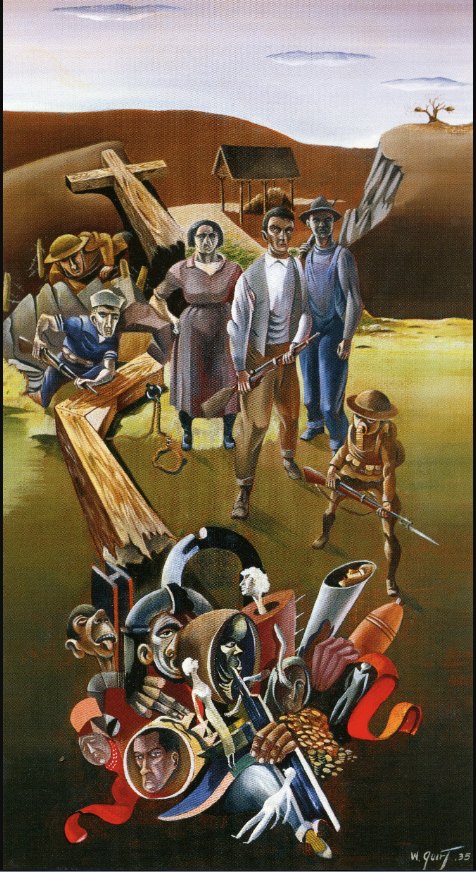
Walter Quirt (1902–1968), "The Future Is Ours" (1935)
Posted By: Paul - Thu Apr 29, 2021 -
Comments (0)
Category: Art, Surrealism, 1930s
Yu Qian’s Tower of Teeth
We've previously posted about the Tooth Stone of Elkhart, Indiana, which is a large, concrete block full of human teeth.Along similar lines is the Tooth Tower of Yu Qian in Beijing. It's a large sculpture made out of 28,000 human teeth.
If I come across any more sculptures made out of human teeth, I'll be sure to add them to this list.

Elko Daily Free Press - July 28, 1995

Posted By: Alex - Thu Apr 22, 2021 -
Comments (2)
Category: Art, Teeth
The Ettl Enlarging Machine
I would love to see a picture of this gadget, but cannot find one online. I assume all such work today is done easily on computers.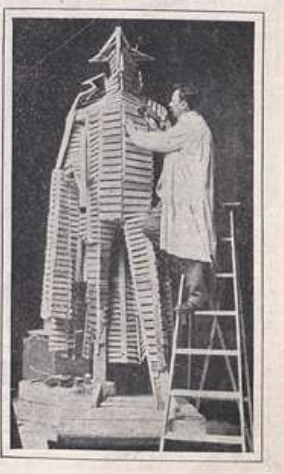
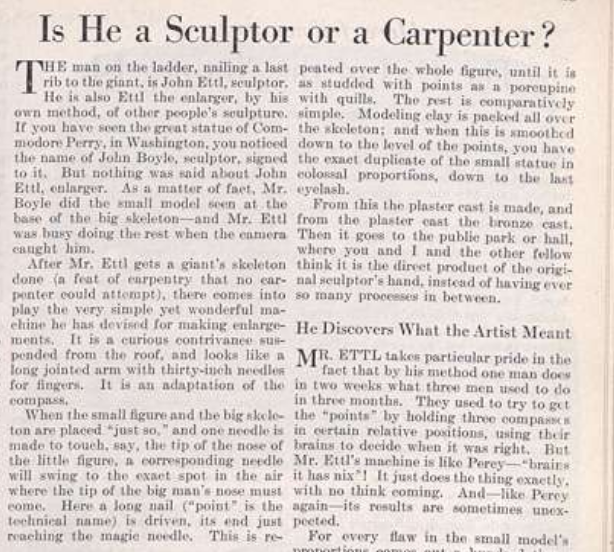
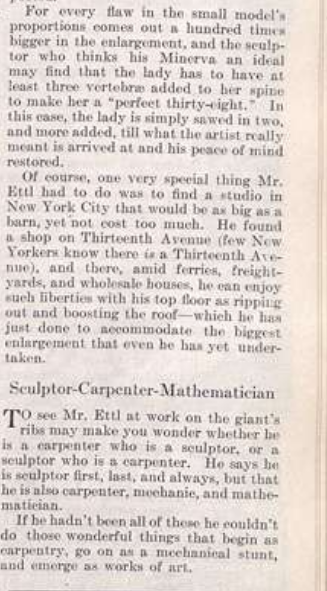
Source.
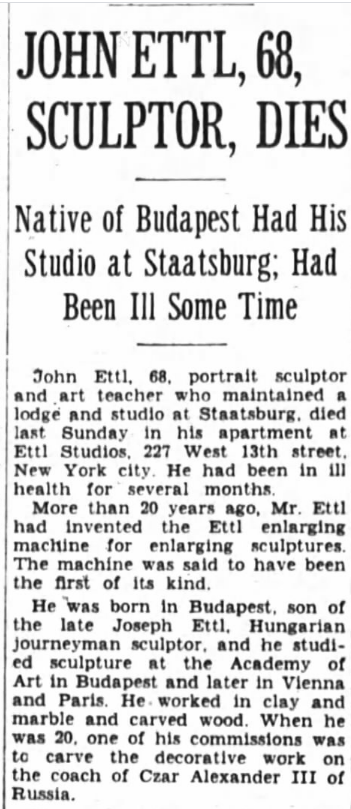
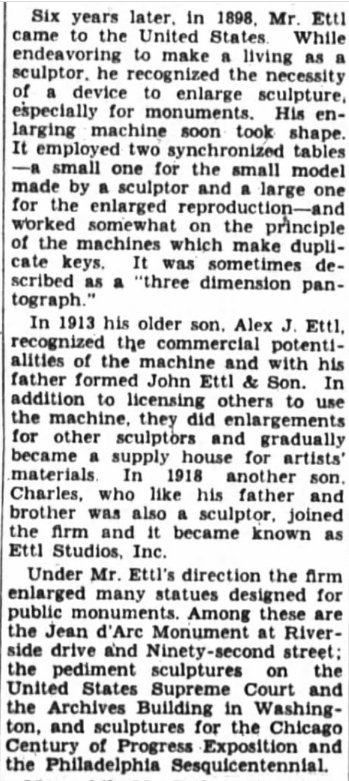
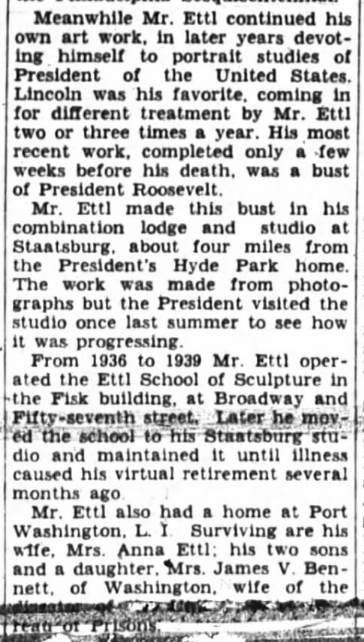
Posted By: Paul - Thu Apr 22, 2021 -
Comments (3)
Category: Art, Statues and Monuments, Inventions, 1910s
Roger Powell, Human Work of Art
In 1995 Roger Powell was 46 years old and living homeless on the streets of London after the failure of his taxi business. And then, by a strange twist of fate, his life changed and he became a work of art.Film director Tony Kaye had decided to display a homeless person as a work of art at the Saatchi Gallery. So he sent his assistant out to find a homeless person willing to go along with this scheme, and Powell was the one found.

Powell on display at the Saatchi Gallery. Source: alamy.com
Powell sat in the gallery beside a sign explaining that he was for sale as a "human work of art." The price: £1000.
As far as I know, no one offered to buy Powell. Nevertheless, Kaye continued to display Powell at various museums for the next two-and-a-half years, but most of the time not as an official exhibit. Powell would simply walk around the museums while wearing a t-shirt that said "For Sale, Roger, By Tony Kaye, Four Million Pounds." (The sale price had inflated quite a bit.) In return for doing this, Kaye paid Powell a small weekly allowance and gave him some money towards rent.

San Francisco Examiner - Nov 19, 1995
Eventually Kaye lost touch with Powell. Then, in 2002 Powell died. Kaye paid for Powell's cremation and received his ashes. He said he planned to use them to create a painting that would say "Dead Homeless Man." I don't know if he ever completed this work.
More info: upi.com, CSMonitor
Posted By: Alex - Tue Apr 20, 2021 -
Comments (0)
Category: Art, 1990s
Unauthorized Dwellings 16
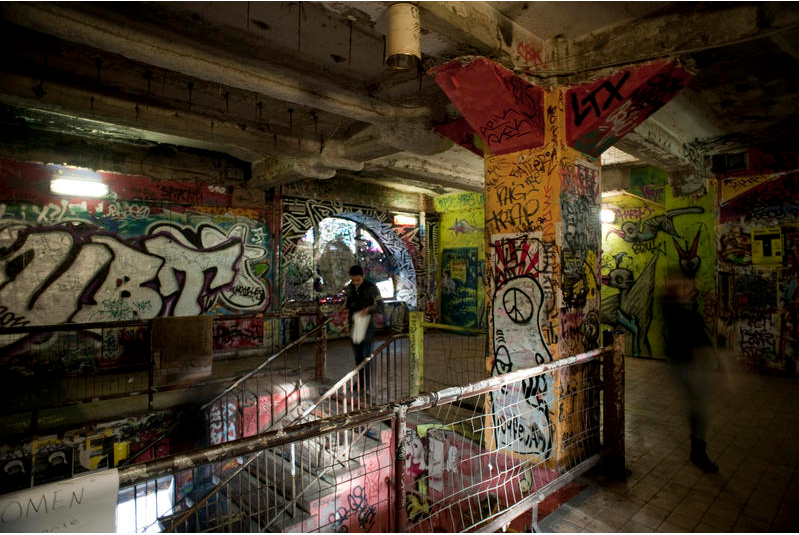
If you walked down Mitte’s Oranienburger Straße at any point between 1990 and 2012, you would have likely noticed a commanding, if dishevelled, structure located just a short distance from the synagogue. Up until five years ago, the second-most visited art attraction in Berlin wasn’t the East Side Gallery or Museum Island, it was this five-storey building: aka Kunsthaus Tacheles. Taken over by artists after the Wall fell in 1990, the building was transformed into a creative commune. It was quintessential post-Wende Berlin: upon their occupancy, the artists launched a legal battle for the property and rescued it from demolition, maintaining a presence for 22 years.
Full essay here.
The Wikipedia page.
Posted By: Paul - Mon Apr 19, 2021 -
Comments (0)
Category: Antisocial Activities, Art, Outsider Art, Unauthorized Dwellings, 1900s, 2000s, 2010s, Europe
Arnulf Rainer
An experimental film from 1960 about flicker effect. Or, as one commenter on YouTube puts it, "One of the most horrible things ever in the history of the cinema."The film is named after the artist Arnulf Rainer but it's by director Peter Kubelka. Some more info from wikipedia:
Wikipedia also notes that Kubelka refused to digitize the film because "cinema is a completely different medium which cannot be imitated by the digital medium." But it's on YouTube, so someone digitized it.
Posted By: Alex - Fri Apr 16, 2021 -
Comments (1)
Category: Art, Movies, 1960s
Uke-TEL NAKI-U1
"Uke-TEL NAKI-U1" is the 1993 creation of the 'art collective' Maywa Denki (brothers Masamichi and Nobumichi Tosa), who specialize in creating "useless machines". They offer the following description of 'Uke-TEL' on their website:Or, as explained by We Make Money Not Art:

Seems to me its use is to kill goldfish, which makes it relevant to the controversy, previously posted about, concerning the legal rights of goldfish.
Posted By: Alex - Tue Mar 30, 2021 -
Comments (0)
Category: Art, Fish, 1990s

| Who We Are |
|---|
| Alex Boese Alex is the creator and curator of the Museum of Hoaxes. He's also the author of various weird, non-fiction, science-themed books such as Elephants on Acid and Psychedelic Apes. Paul Di Filippo Paul has been paid to put weird ideas into fictional form for over thirty years, in his career as a noted science fiction writer. He has recently begun blogging on many curious topics with three fellow writers at The Inferior 4+1. Contact Us |




